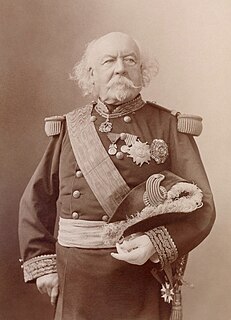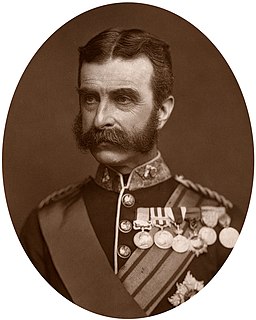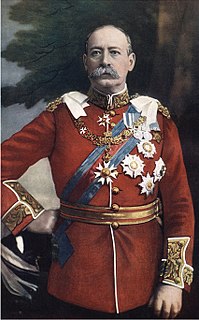Alastair Macdonald | |
|---|---|
| Allegiance | |
| Service/ | |
| Rank | General |
| Commands held | Commander-in-Chief, Scotland |
| Battles/wars | Crimean War |
General Alastair M'Ian Macdonald was a British Army officer who became Commander-in-Chief, Scotland.
Alastair Macdonald | |
|---|---|
| Allegiance | |
| Service/ | |
| Rank | General |
| Commands held | Commander-in-Chief, Scotland |
| Battles/wars | Crimean War |
General Alastair M'Ian Macdonald was a British Army officer who became Commander-in-Chief, Scotland.
Macdonald was commissioned as an ensign in the 92nd Regiment of Foot in 1846 and became aide-de-camp to Sir John Pennefather in 1854. [1] He fought at the Battle of Alma in September 1854 and the Battle of Inkerman in November 1854 during the Crimean War. [1] He became Assistant-Adjutant-General at Dover and then aide-de-Camp to the Duke of Cambridge. [1] Promoted to major-general, he went on to command the troops in the North British District in 1881 [2] before retiring in 1885. [1]
In August 1881 he oversaw and commanded the second Royal Volunteer Review in Holyrood Park with 44,000 soldiers parading in front of Queen Victoria. [3]

François Marcellin Certain de Canrobert was a French Marshal. He demonstrated ability during the Second French Empire while participating in the Battle of Alma, the Battle of Magenta, the Battle of Solferino and the Battle of Gravelotte. A staunch supporter of Napoleon III, he became, under the French Third Republic, one of the leading figures in the Bonapartist party and chairman, from 1876 to 1894, of the Senate within the French parliamentary group "Call upon the people".

Field Marshal FitzRoy James Henry Somerset, 1st Baron Raglan,, known before 1852 as Lord FitzRoy Somerset, was a British Army officer. When a junior officer, he served in the Peninsular War and the Waterloo campaign, latterly as military secretary to the Duke of Wellington. He also took part in politics as Tory Member of Parliament for Truro, before becoming Master-General of the Ordnance. He became commander of the British troops sent to the Crimea in 1854: his primary objective was to defend Constantinople, and he was also ordered to besiege the Russian Port of Sevastopol. After an early success at the Battle of Alma, a failure to deliver orders with sufficient clarity caused the fateful Charge of the Light Brigade at the Battle of Balaclava. Despite further success at the Battle of Inkerman, a poorly coordinated allied assault on Sevastopol in June 1855 was a complete failure. Raglan died later that month, after having dysentery and depression.

Field Marshal Colin Campbell, 1st Baron Clyde,, was a British Army officer. After serving in the Peninsular War and the War of 1812, he commanded the 98th Regiment of Foot during the First Opium War and then commanded a brigade during the Second Anglo-Sikh War. He went on to command the Highland Brigade at the Battle of Alma and with his "thin red line of Highlanders" he repulsed the Russian attack on Balaclava during the Crimean War. At an early stage of the Indian Mutiny, he became Commander-in-Chief, India and, in that role, he relieved and then evacuated Lucknow and, after attacking and decisively defeating Tatya Tope at the Second Battle of Cawnpore, captured Lucknow again. Whilst still commander-in-chief he dealt with the "White Mutiny" among East India Company troops, and organised the army sent east in the Second Opium War.

Étienne Jacques-Joseph-Alexandre Macdonald, 1st Duke of Taranto, was a Marshal of the Empire and military leader during the French Revolutionary and Napoleonic Wars.

Frederic Augustus Thesiger, 2nd Baron Chelmsford, was a British Army officer who rose to prominence during the Anglo-Zulu War, when an expeditionary force under his command suffered a decisive defeat at the hands of a Zulu force at the Battle of Isandlwana in 1879. Despite this defeat, he was able to score several victories against the Zulus, culminating in the British victory at the Battle of Ulundi, which ended the war and partly restored his reputation in Britain.

Field Marshal Francis Wallace Grenfell, 1st Baron Grenfell, was a British Army officer. After serving as aide-de-camp to the Commander-in-Chief, South Africa, he fought in the 9th Xhosa War, the Anglo-Zulu War and then the Anglo-Egyptian War. He went on to become Sirdar (Commander-in-Chief) of the Egyptian Army and commanded the forces at the Battle of Suakin in December 1888 and at the Battle of Toski in August 1889 during the Mahdist War. After that he became Governor of Malta and then Commander-in-Chief, Ireland before retiring in 1908.

Major-General Sir George Cathcart was a British general and diplomat.

General Richard Airey, 1st Baron Airey,, known as Sir Richard Airey between 1855 and 1876, was a senior British Army officer of the 19th century.

Lieutenant General Sir Frederick William Stopford was a British Army officer, best remembered for commanding the catastrophic landing at Suvla Bay in August 1915, during the Gallipoli Campaign.

Field Marshal Sir Frederick Paul Haines was a British Army officer. He fought in the First Anglo-Sikh War, in the Second Anglo-Sikh War and then in the Crimean War: during the latter conflict at the Battle of Inkerman, he held an important barrier on the post road guarding the approach to the 2nd Division camp for six hours. He served in India during the Indian Rebellion before becoming Commanding Officer of the 8th Regiment of Foot in the United Kingdom and then Commander of a Brigade in Ireland. He went on to be General Officer Commanding the Mysore Division of the Madras Army and then Quartermaster-General to the Forces in the United Kingdom. He returned to India to become Commander-in-Chief of the Madras Army in May 1871 and then Commander-in-Chief, India in April 1876: he commanded the forces in India during the Second Anglo-Afghan War and successfully argued for a large force being made available before mobilisation occurred, but once the war started the Governor-General of India, Lord Lytton, was inclined to by-pass Haines and deal direct with commanders in the field, causing friction between the two men.

General Sir Charles Whittingham Horsley Douglas, was a British Army officer who served in the Second Anglo-Afghan War, the First Boer War, the Suakin Expedition, the Second Boer War and the First World War. He was Chief of the Imperial General Staff during the first three months of the First World War but died from strain and overwork without having any meaningful influence on the outcome of the war.

Field Marshal Sir Alexander George Woodford, GCB, KCMG, was a British Army officer. After taking part in the Anglo-Russian invasion of Holland, he served in most of the battles of the Napoleonic Wars. During the Hundred Days he commanded the 2nd battalion of the Coldstream Guards at the Battle of Quatre Bras, the Battle of Waterloo and the storming of Cambrai. He went on to become lieutenant governor and brigade commander at Malta, lieutenant governor and brigade commander at Corfu and then commander of the British garrison on the Ionian Islands before being appointed Governor and Commander-in-Chief of Gibraltar.

General Sir Thomas Montagu Steele was a British army officer.

Field Marshal Sir Charles Henry Brownlow was a senior Indian Army officer. He served on the North West Frontier in the Hazara Campaign of 1853 and the campaign against the Mohmands in 1854. At the start of the Indian Mutiny, Brownlow was asked to raise an infantry regiment and formed the 8th Punjab Infantry which he commanded during that campaign, the Second Opium War, the Ambela Campaign and the Hazara Campaign of 1868. He commanded a column for the Lushai Expedition and then served as Assistant Military Secretary for India for ten years. After his retirement, as senior retired officer of the Indian Army, he was promoted to field marshal.
Sir James Talbot Airey was an officer of the British Army. He served during the First Anglo-Afghan War and the Crimean War, rising to the rank of general.
Colonel Sir Charles Mansfield KCMG was a British army officer and diplomat, envoy to several countries.
General Sir Thomas Reed, was a British Army officer and the 20th General Officer Commanding, Ceylon.

General Sir Edmund Haythorne was a British Army officer who served as Adjutant-General in India.
General Sir John Alexander Ewart GCB was a 19th-century British military leader who commanded the Gordon Highlanders and several other important British regiments. A hero of the Siege of Lucknow he spent the second half of his life without his left arm. A favourite of Queen Victoria he served as her official aide-de-camp.

Marcos Segundo Maturana Molina was a Chilean military and art collector. Given his service in the War of the Pacific against Peru and Bolivia he is regarded a war hero by the Chilean army. Maturana is known for organising the National Museum of Paintings of Santiago, currently known as the National Museum of Fine Arts of Santiago de Chile.